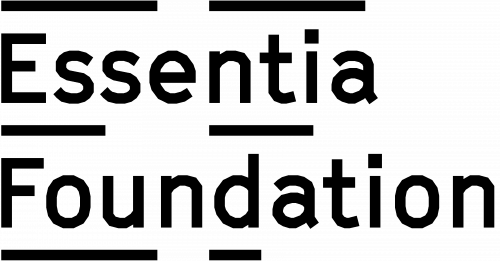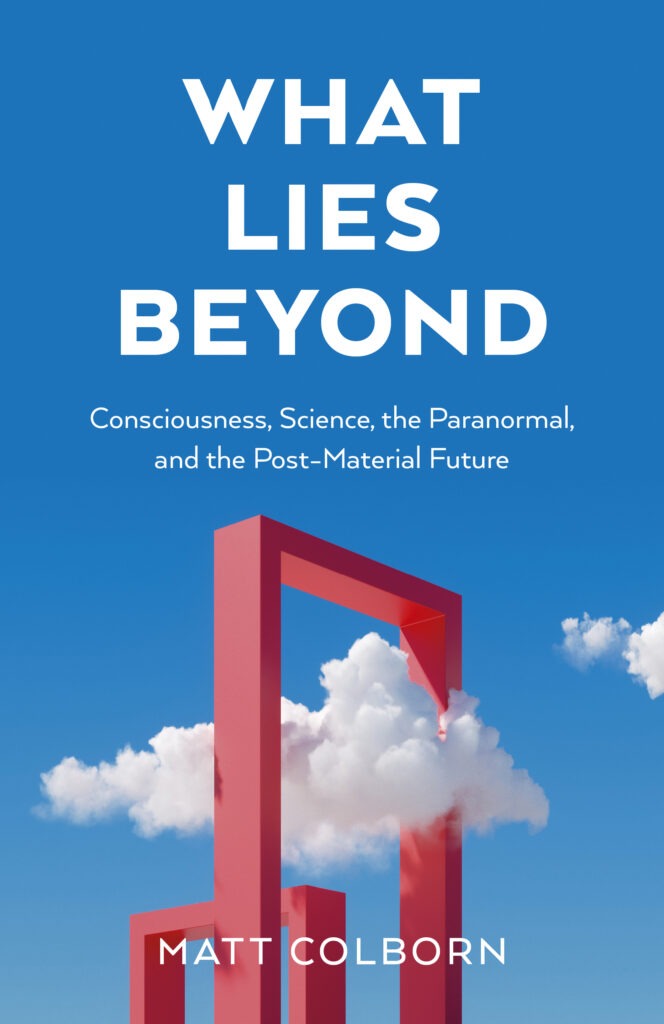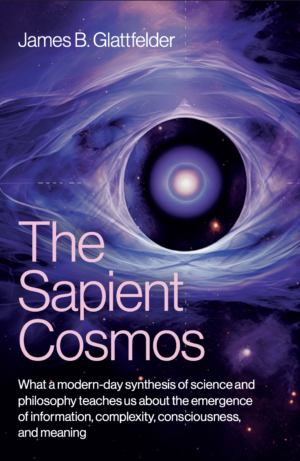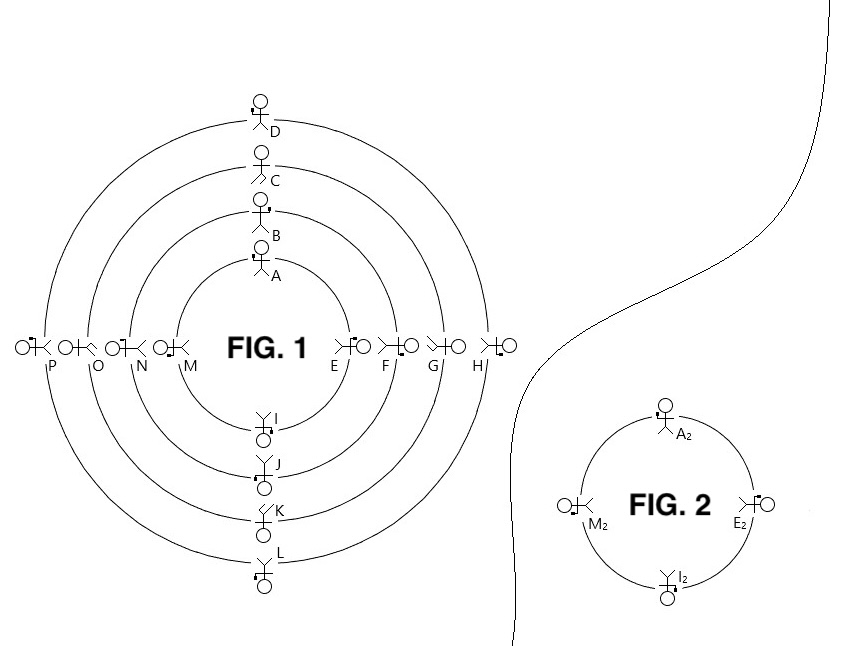Open worldviews: Against the degradation of humanity
Reading | Cognitive Science
![]() Matt Colborn, PhD | 2025-06-27
Matt Colborn, PhD | 2025-06-27

Dr. Colborn argues that, perhaps surprisingly, the worldview of the technology elite is shifting from fundamentalist materialism to a form of apocalypticism that echoes fundamentalist Christianity. This shift in belief is, according to Colborn, not based on an honest search for truth, but instead an attempt to legitimize agendas of power and control. As such, it risks dehumanizing humanity. The analysis in this essay is particularly important in today’s world of emerging agentic AI, wherein—insofar as we believe that AI mechanisms are conscious—we may end up believing that conscious beings are mere mechanisms. Dr. Colborn has just published a book with our own imprint, Essentia Books: What Lies Beyond.
April 2025: in a Guardian article, progressive writers Naomi Klein and Astra Taylor described a strange mutation in the belief systems of some previously secular Silicon Valley elites [1]. This was of interest because I’d devoted a chapter to critiquing the extreme materialism of Silicon Valley in my book, What Lies Beyond: Consciousness, Science, the Paranormal, and the Post-Material Future (Essentia Books, 2025). According to Douglas Rushkoff, Silicon Valley style materialism is founded on the “mechanomorphic” belief that reality is “computational,” that “everything is data” and that “humans are processors” [2]. The strange mutation was the sudden conversion of several of the Silicon Valley elite from “mechanomorphic” materialism to fundamentalist, end-times Christianity.
This mutation might seem difficult to explain. On the face of it, pivoting from fundamentalist materialism to fundamentalist Christianity makes little sense. Later on I will argue that such a shift in fact makes a great deal of sense, although it is not the main problem. The main problem is with what Karl Marx called ruling ideas—that is, ideas held by elites and supported by large cultural institutions [3]; specifically, with ideas that offer a justificatory framework for the actions of those elites. Both “mechanomorphic” materialism and end-times Christianity arguably supply just such justificatory frameworks for the world-shaping ambitions of Silicon Valley.
In this essay, I will (1) argue that these particular ruling ideas present a highly impoverished vision of humanity; that they in fact represent a degradation of humanity for essentially instrumental purposes. In response, I will (2) propose what I will call open worldviews. Open worldviews can potentially counter this degradation by honouring the wider spectrum of human experience, including those that suggest post-materialist views of reality. In the context of a global ‘polycrisis’ that may possibly lead to climate-induced collapse, open worldviews offer a potentially powerful counter to dangerous and monopolistic ruling ideas.
The politics of materialism
Materialism has always had a political dimension. The liberal dimension of this was described by Theodore Roszak [4]. Roszak pointed out that initially a ‘materialist’ explanation simply meant an explanation that did not require God. In the eighteenth and nineteenth centuries materialist explanations were used to challenge ecclesiastical power, and especially the power of the Catholic Church. This was necessary because the Catholic Church played a large role in affirming the divine right of kings, which gave monarchs unquestioned power. Materialism therefore became associated with ‘left-wing’ and, later, liberal thought.
In the twentieth century materialism and a philosophy called logical positivism came to be seen as a defence against “fascist hysteria” [5]. A key proponent of this perspective was Bertrand Russell. In his 1903 essay A Free Man’s Worship, he insisted that hard-line materialism was the only reasonable worldview in the light of current scientific knowledge. The implication was that to be a liberal humanist was also necessarily to be a scientific materialist.
In the twenty-first century, the claim that science and materialism are synonymous has become an integral part of the liberal defence against religious fundamentalism and fascism. In a book defending evolution, biologist Jerry Coyne insisted that naturalistic materialism was the only possible metaphysic for science [6]. Materialist perspectives on consciousness have also been actively used as counterbalances to right-wing new age ‘alternative’ views that reject materialism. One example: the hosts of the progressive Conspirituality podcast explicitly state their support for materialist views of consciousness.[7] This stance informs their extended critique of internet wellness ‘gurus,’ who claim to embrace transcendent consciousness or, more recently, fundamentalist Christianity. It seems difficult to ignore the political utility of such a stance.
Silicon Valley’s iterations of materialism have been of a different order. They are not obviously linked to a progressive or ‘left wing’ political perspective. Rather, they seem yolked to extreme free-market economics of a particular kind, and more recently overt technofascism [8]. Rushkoff called the central philosophy ‘the Mindset’ [9]. The ‘Mindset’ is based on “staunchly atheistic and materialistic scientism” and “a faith in technology to solve problems” [10]. ‘The Mindset’ is ruthlessly extractive. It exists for the purpose of accumulating technological power and wealth. It appropriates science, or a veneer of science, for its own ends.
The Mindset basically exists as a justification for the accumulation of vast quantities of money and power. Staunch materialism helps with this because a world of ‘fields and forces,’ where consciousness is an epiphenomenon and values are ‘only’ subjective, can easily be interpreted as amoral. In an amoral world, potentially anything goes. Such a worldview is not a million miles from the philosophy of the Marquis de Sade [11]. This is the shadow side of materialism and demonstrates its use as a ruling idea. A worldview like the Mindset justifies actions that, in other contexts, might be seen as immoral or even monstrous.
Two interchangeable fundamentalisms?
This essentially utilitarian use of materialism might help explain the transience of Silicon Valley beliefs. Worldviews might be adopted for expedience and not factual truth. What matters is whether your chosen worldview enables your actions. One could argue that, in the current political climate, end times Christianity has become more convenient than materialism.
However, I do not believe that things are quite so simple. I think that the ease with which some have converted is an indication that these seemingly opposed philosophies in fact share some basic principles. This is because the hard-line materialism of Silicon Valley is also an end-times philosophy. This is made explicit by Rushkoff’s other term for the Mindset: ‘Silicon Valley escapism.’ This ‘escape’ means leaving a trashed planet behind for a high-tech future either in outer space or within virtual worlds. The technological singularity, an item of faith for many in Silicon Valley, has even been termed ‘the Rapture of the Nerds.’
So the common denominator of end times Christianity and “mechanomorphic” materialism is an apocalyptic belief structure. This belief structure is that the end of (this) world is coming and that most people will perish, except for a special elite of chosen people. Such apocalypticism is thousands of years old and possibly has its origins in ancient Iranian Zoroastrianism [12]. The historian Norman Cohn traced its spread through the Middle East and its influence on Judaism and Christianity in the ancient and medieval worlds. Apocalypticism also influenced ostensibly secular, twentieth century totalitarian movements like Nazism and Communism [13].
In this respect, the belief systems are interchangeable. This was confirmed by the strange experience of writer Meghan O’Gieblyn [14]. O’Gieblyn lost her faith in evangelical Christianity, dropping out of Bible school, but in 2006 embraced transhumanism as an alternative. After a plunge down a metaphysical rabbit hole, she came to see that, although she had disavowed Christianity, she had “spent the past 10 years hopelessly trying to re-create its visions by dreaming about our post-biological future,” which she dubbed “a modern pantomime of redemption.” O’Gieblyn’s experience underlines the common underlying structures of both belief systems.
Cohn saw millenarian movements as very dangerous and potentially genocidal. But there is another problem. Fundamentalist materialism and fundamentalist Christianity both present highly impoverished views of humanity. Within both worldviews, humans stop being autonomous, conscious agents with free will and instead become puppets in a cosmological drama that ends either in an ‘inevitable’ technological singularity or the ‘inevitable’ second coming of Christ. Either way, most of us are damned.
So there exist solid reasons to oppose these apocalyptic and fascist belief systems. For most, such worlds become closed, stifling, vicious and oppressive. Progressive writers like Klein and Taylor describe such belief systems as “genocidal at [their] core and treasonous to the wonder and beauty of this world.” I would concur with this assessment but need to point out a problem with the opposition.
Open worldviews in an open society
The problem is the common assumption that ‘liberal humanist’ must equal ‘scientific materialist,’ and that this association exists as a necessary defence against “fascist hysteria.” Is such a link really as inevitable as Bertrand Russell seemed to think? One challenge to this claim is the association of hard-line materialism with fascism. Another is the potential evolution of post-materialist worldviews within science itself. Yet another is the existence of viable visions of the world that are both non-materialist and naturally opposed to far-right end-times fascism. Indigenous traditions might stand as an example. In short: the ‘humanistic progressive equals scientific materialist’ equation seems questionable and needs revision.
In 1945 the philosopher Karl Popper published his book The Open Society and Its Enemies. This was essentially a defence of liberal, open societies that defended the freedom and autonomy of individuals against totalitarianism. In the spirit of Popper’s work, I would like to suggest the concept of open worldviews. An open worldview is one that is pluralistic, encompassing, open to critique and modification, and open to empirical refutation. In other words, it is something like an ideal ‘scientific’ worldview. But it would also go beyond.
There are a number of possible elements to an open worldview. One might be attention to the full spectrum of human experience. Taking a cue from William James’ radical empiricism, it would take experience as the ultimate reality, as opposed to theoretical hidden or transcendent realities beyond experience [15]. I would also draw from Iain McGilchrist’s arguments for reclaiming intuition and imagination, as well as ‘science’ and ‘reason,’ as pathways to truth [16]. These elements might act as counters to the closed worlds of fundamentalist religion, scientism or totalitarian politics.
In addition, an open worldview would need to include what has been called post-normal science. Essentially, this involves integrating other ways of knowing as well as positivistic science. Pablo Servigne, Raphaël Stevens and Gauthier Chappelle offer some valuable insights into post-normal science in the light of the unfolding polycrisis and possible climate-induced societal collapse. They emphasise the importance of breaking out from “established ways of thinking” and opening up “new horizons” [17]. This includes a fresh consideration of things like intuition, as well as indigenous psychologies and knowledge systems. Post-normal science is pluralistic, open to diverse ways of seeing the world and diverse modes of existence, all of which seem to me essential counters to totalist worldviews that insist that they are the One True Reality.
The post-materialist element?
Allied to this is the strong sense of a need to move to post-materialist worldviews. The theoretical, philosophical case for this has been provided in a number of recent works. Thomas Nagel’s 2012 Mind and Cosmos rightly points out the limitations of what he calls the materialist, neo-Darwinian conception of reality. Nagel suggested that it was highly unlikely that we are anywhere near an ultimate understanding of reality and that it is quite possible that we do not even currently have the conceptual tools for an understanding. This means that the materialist, neo-Darwinian conception of reality, which has been pushed so hard as a counter to fundamentalist religion, is likely itself false.
Other thinkers have offered strong reasons for moving to a scientifically viable, post-materialist vision of reality. I would point to Bernardo Kastrup’s Analytic Idealism in a Nutshell, Federico Faggin’s Irreducible and Iain McGilchrist’s The Matter with Things as offering solid theoretical foundations for such a worldview-shift. Ed Kelly et al.’s books Irreducible Mind and Consciousness Unbound attempt to provide an empirical justification for a similar move from materialist to post-materialist views of consciousness.
But Nagel’s central point—that we are unlikely to be anywhere close to a final understanding of the cosmos—for me means that any vision of the world that we adopt must be highly tentative, open to revision and open to alternatives. Such openness seems to me a better counter to fascist, fundamentalist, totalitarian thought than insisting on dogmatic forms of materialism.
The problem of meaning
There is a further, essential element to ‘open worldviews’ that I think is necessary to counter the virulence of the new apocalypticism. In The Free Man’s Worship, Bertrand Russell wrote that realistic, post-religious philosophies could be built “only on the firm foundation of unyielding despair” at the transience of human life in a vast, ancient and hostile universe that was bound to perish in heat-death [18].
I am not going to deny that Russell’s assessment has an element of truth when a human life is considered on cosmological scales. From an astronomical, distancing perspective, human life can indeed appear as a mote in infinity. However, I would say that an insistence on “unyielding despair” has never been a selling point for the promotors of any form of liberal humanism that is yolked to hard-line scientific materialism.
This could, in the current social, cultural and political moment of resurgent fundamentalisms, be a real problem. In an essay entitled ‘Beliefs,’ Aldous Huxley suggested that the philosophies of meaninglessness that flourished after World War I became the soil in which totalitarianism eventually flourished. This was because human beings, having abandoned traditional religion, did not stop thirsting for meaning in their lives. This meaning, no longer inherent in the universe, was sought in “the hard, ferocious philosophies of nationalistic and revolutionary idolatory” [19].
Huxley’s description has uncanny echoes today. One reason why destructive and apocalyptic worldviews might have spread so easily is precisely because of a wide crisis of meaning. In What Lies Beyond I suggest that one way out of this crisis is via a capacity for relational consciousness; a capacity that has traditionally been linked to mysticism and spirituality (and so was automatically rejected by positivistic philosophers like Russell).
But I think that the extremity of our situation forces a reconsideration of those states of being that have for millennia fed our various wisdom traditions. Here, I am following the lead of the biologist Sir Alister Hardy, who believed spiritual awareness to be a human basic [20]. Hardy believed that such awareness naturally developed in the course of evolution and was as integral to human beings as language.
In his 2007 book, a protege of Hardy’s, David Hay, suggested that the suppression of spiritual awareness, common in industrial consumer societies, is damaging. He believed that
…many of our most pressing social and political problems—meaningless, the collapse of a sense of community, the draining away of trust and social capital in general, the turning of everything into a commodity, and carelessness about the ecology of the planet—have their origin in the ignoring of the aspect of our human nature adapted to deal with them, relational consciousness or spirituality. [21]
Here, Hay supplies very practical reasons for paying attention to the broader spectrum of human experience. The kind of liberal humanist rationalism that insists on “unyielding despair,” along with hard-line scientific materialism, simply cannot compete with movements that offer even phoney transcendence. But if relational consciousness is a human basic, as Hardy suggested, then its suppression in industrial consumer societies, along with philosophies of “unyielding despair,” might well have left whole populations vulnerable to toxic substitutes.
Conclusion
The flowering of end-times fascism and problems with existing humanistic alternatives seem to me to indicate an urgent need to develop new visions of reality. This means that the assumptions that liberal humanists in particular have inherited from the twentieth century by now seem questionable. Servigne, Stevens and Chappelle are therefore right to point to the need to break out from established patterns of thought and seek new horizons. In other words, it is no longer sufficient to oppose toxic belief systems. Nor is it satisfactory merely to defend the eroding ‘secular space.’ One must offer better, empowering options. For me, open, evolving and post-materialist worldviews might prove fertile ground for seeding new, vital and humane visions of the world.
References
[1] Klein, N. & Taylor, A. (2025 13 April). The rise of end times fascism. The Guardian. https://www.theguardian.com/us-news/ng-interactive/2025/apr/13/end-times-fascism-far-right-trump-musk
[2] Rushkoff, D. (2019). Team human. W. W. Norton & Company, p. 79.
[3] Marx, K. (1932). The German ideology. https://www.marxists.org/archive/marx/works/1845/german-ideology/ch01b.htm
[4] Roszak, T. (1992). The voice of the Earth. Phanes.
[5] Roszak, 1992, p. 99.
[6] Coyne, J. 2009. Why evolution is true. Oxford: Oxford Landmark Science, p. 244.
[7] Beres, D. & Remski, M. (2021). Bonus sample: the question of consciousness. Conspirituality. Available at: https://podcasts.apple.com/gb/podcast/conspirituality/id1515827446?i=1000532821055
[8] Lewis, B. (2025 Jan 29). ‘Headed for technofascism’: the rightwing roots of Silicon Valley. The Guardian. https://www.theguardian.com/technology/ng-interactive/2025/jan/29/silicon-valley-rightwing-technofascism
[9] Rushkoff, D. (2022). Survival of the richest: escape fantasies of the tech billionaires. Scribe.
[10] Rushkoff, 2022, p. 58.
[11] Lachman, G. (2013). The caretakers of the cosmos: Living responsibly in an unfinished world. Floris.
[12] Cohn, N. (1995). Cosmos, chaos and the world to come : The ancient roots of apocalyptic faith. Yale University Press.
[13] Cohn, N. (1983). The Pursuit of the Millennium: Revolutionary millenarians and mystical anarchists of the middle ages. Oxford University Press.
[14] O’Gieblyn, M. (2017 18 April). God in the machine: my strange journey into transhumanism. The Guardian. https://www.theguardian.com/technology/2017/apr/18/god-in-the-machine-my-strange-journey-into-transhumanism
[15] James, W. (1912). Essays in radical empiricism. Longmans, Green & Co.
[16] McGilchrist, I. (2021). The matter with things: Our brains, our delusions and the unmaking of the world. Perspectiva Press.
[17] Servigne, P., Stevens, R. & Chapelle, G. (2021). Another end of the world is possible. Polity, p. 72.
[18] Russell, B. (1903). The free man’s worship. https://users.drew.edu/~jlenz/br-free-mans-worship.html
[19] Huxley, A. (2009). Beliefs. In A.Huxley. The perennial philosophy. HarperPerennial, p12.
[20] Hardy, A. (1979). Spiritual nature of man: Study of contemporary religious experience. Oxford University Press
[21] Hay, D. (2007). Why spirituality is difficult for westerners. Imprint Academic, p. 2.


























